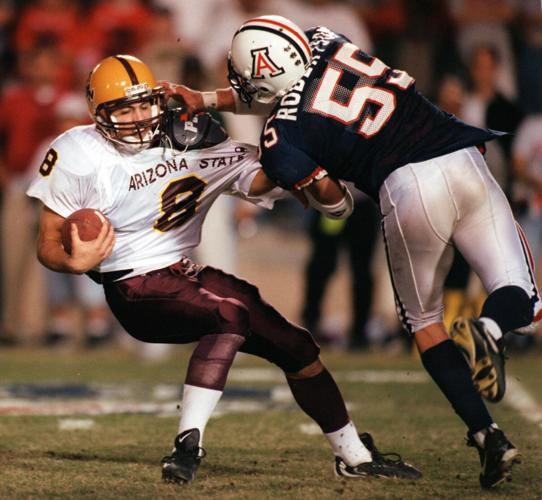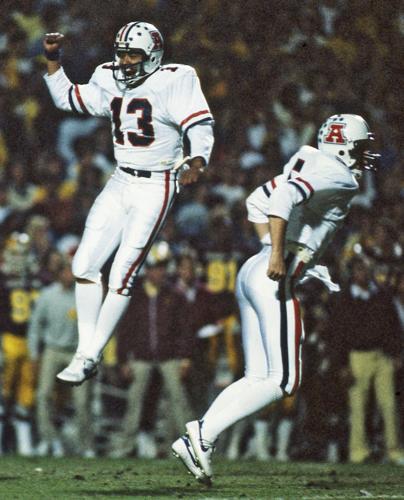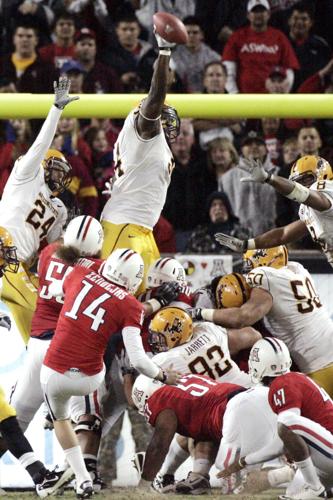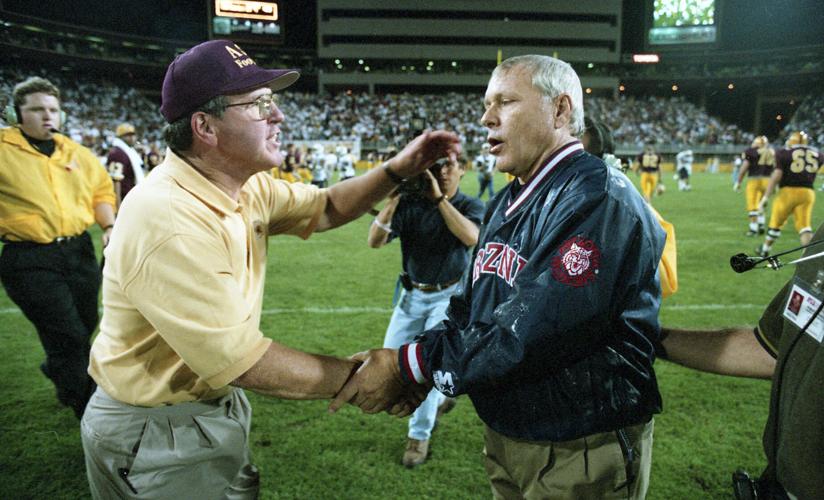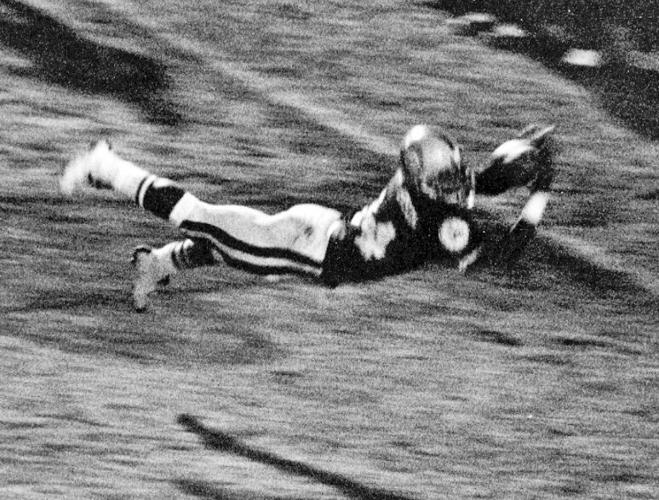Two teams that have lost 15 games between them, couldn’t hold a high school team scoreless, and ran up 27 points between them last week while their opponents were scoring 62, meet Friday in the season’s final game.
What do we call it?
The Game of the Year.
The winner will receive the Territorial Cup, which is considered so sacred that 21 years ago Arizona and ASU signed a contract that specifies no one can handle the Cup unless they wear “white cotton gloves.”
Don’t you just love it? It’s the best rivalry in Pac-12 football. Better than the Apple Cup. Superior to whatever USC and UCLA call their rivalry. Better than what the Oregon schools used to call the Civil War.
If you thought the Territorial Cup was forever ruined when the Sun Devils toyed with Arizona 70-7 two years ago — prompting the most famous billboard in Interstate 10 history, the ingenious “No Pity For the Kitty” laugh-riot near Casa Grande — you are wrong.
That 70-7 game was the best thing that has happened to Arizona football since Chuck Cecil’s 106-yard interception return to beat the Sun Devils in the 1986 Territorial Cup, putting a painful and indelible smudge on ASU’s Rose Bowl resume.
It led to the firing of asleep-at-the-wheel UA coach Kevin Sumlin, which was worth, what, 10 victories itself to Wildcat fans hoping for a sign of hope?
One of the many reasons the Territorial Cup is the Pac-12’s most imperishable rivalry is that the Sumlin-loses-his-job-after-losing-by-63 was merely a repeat of the series’ fascinating history.
After the 1946 UA-ASU game, won 67-0 by the Wildcats, the Sun Devils (then known as Bulldogs) fired first-year coach Steve Coutchie, even though they had promised Coutchie a minimum of three years after wooing him away from Mesa High School, where he had been Phoenix’s most revered high school coach.
There was no freeway between Tucson and Tempe in 1946 — and no billboard — but the UA’s booster group, the Towncats, sent a telegram to ASU’s booster group, the Sun Angels, with three short words: “Enjoy your meal.” It was the 1940s equivalent of “up yours.”

ASU quarterback Ryan Kealy is sacked by UA's Mike Robertson during the 1998 rivalry game. Arizona's 50-42 win capped the best regular season in program history.
The Territorial Cup doesn’t get any consistent national attention because Arizona and ASU have never met with the Rose Bowl at stake (for both teams). They have never met with both teams ranked in the AP top 10 — the closest was 1975, when ASU was No.8 and Arizona No. 12 — which throws it out of the Ohio State-Michigan and Alabama-Auburn class.
And, no, it can’t match the Army-Navy game.
But it’s the Pac-12’s most heated and historical rivalry and it’s not even close. Why? It’s the only Pac-12 rivalry that has been consistently competitive.
Arizona hangs to a 49-45-1 career lead over ASU.
USC has overwhelmed UCLA 51-33-7.
Washington owns WSU, 74-33-6.
Oregon toys with Oregon State, 67-48-10.
Not only that, the average score of the Territorial Cup series, dating to 1899, is ASU 22.1, Arizona 21.6.

Max Zendejas of UA leaps into the air after booting the game-winning field goal against ASU on Nov. 23, 1985.
A week ago, Cal and Stanford drew just 51,892 for the “Big Game” at Cal. Capacity is 62,467. So much for a “can’t-miss” rivalry. Cal and Stanford are almost football twins, smart guys from cosmopolitan universities. It’s a one-week-a-year thing.
The UA-ASU rivalry goes 24/7, all week, all month, all year.
Oregon and Oregon State are separated by 40 miles of farmland, the Willamette Valley. The nouveau riche Ducks don’t like that image. They don’t like to be compared to the Beavers. That’s why Oregon’s football rivalry with Washington is often viewed as more important than the old Civil War showdown.
USC’s rivalry with Notre Dame has more appeal than its yearly game against UCLA, which doesn’t even have a catchy nickname.
The Apple Cup is the league’s most lopsided rivalry, and in many years Washington’s game against WSU is viewed as secondary to its game against Oregon. WSU and Washington often don’t seem as if they’re in the same state; WSU is only seven miles from Idaho and 251 from Seattle.
The intensity in Arizona goes beyond football. ASU views Tucson as a border town. They call it the “Dirty T.”
Arizona views Phoenix as too hot, too crowded and too big for its britches. The two disagree on everything. Tucsonans would rather be known as part of the state of Baja Arizona, in a league of their own instead of getting the hand-me-downs from Phoenix in everything from business opportunities to flight schedules.
Both sides view the other as “the school down south” or “the school up north,” as if saying “ASU” or “UA” would give the other relevance.

Wildcats players celebrate after edging Arizona State, 27-24, capping the 1979 season.
The most defining memory of the Territorial Cup series didn’t come from Frank Kush, “Jackrabbit” Joe Hernandez, Pat Tillman, Tedy Bruschi or from the 1968 “Ultimatum Bowl.”.
It came from 1982 Arizona All-Pac-10 offensive lineman Jeff Kiewel, who grew up in Tucson, played at Sabino High School and in his final game as a Wildcat, helped to knock the No. 6 Sun Devils out of the Rose Bowl, 28-18.
Two days before the 1982 Territorial Cup, I asked Kiewel what he thought of the UA-ASU rivalry.
“If you win, it’s a game you always remember,” he said. “If you lose, it’s a game you never forget.”
Someone should put on a pair of white cotton gloves and etch Kiewel's words to the surface of the holy Territorial Cup.
Photos: Every U of A vs. ASU football game since 1975

1975: ASU 24, UA 21 – "The Catch" by Arizona State University receiver John Jefferson during the 1975 ASU/UA football game. Courtesy ASU

1976: ASU 27, UA 10 – This ASU receiver missed the catch, but ASU won the game against UA on Nov. 27, 1976. Arizona Daily Star

1977: ASU 23, UA 7 – Arizona State’s Bob Pfister raises his arms over a downed University of Arizona quarterback Marc Lunsford after ASU forced a 2-point safety on Nov. 26, 1977 in Tempe, Ariz. ASU won, 23-7. P.K. Weis / Tucson Citizen

1978: ASU 18, UA 17 – Arizona State quarterback Mark Malone is sacked by an University of Arizona defender in Arizona Stadium on Nov. 25, 1978. H. Darr. Beiser / Tucson Citizen

1979: UA 27, ASU 24 – Arizona Wildcats players celebrate after edging Arizona State, 27-24, in Tempe on Nov. 24, 1979. H. Darr Beiser / Tucson Citizen

1980: ASU 44, UA 7 – UA fullback Courtney Griffin is wrapped up by the ASU defense on Nov. 29, 1980 in Tucson, when the north end zone was still wide open. P.K. Weis / Tucson Citizen

1981: ASU 24, UA 13 – The celebration was short-lived for the Wildcats, since the Sun Devils pulled off a victory on at wet, muddy day on Nov. 28, 1981. Peter Weinberger / Tucson Citizen

1982: UA 28, ASU 18 – University of Arizona quarterback Tom Tunnicliffe looks to pass during the 1982 ASU/UA football game. Tucson Citizen

1983: UA 17, ASU 15 – The Arizona offense stretches for yardage against ASU on Nov. 26, 1983 in Tempe. Glenn Capers / Tucson Citizen

1984: UA 16, ASU 10 – The goal posts came down at Arizona Stadium on Nov. 24, 1984, as Arizona edged ASU. David Schreiber / Tucson Citizen

1985: UA 16, ASU 13 – Max Zendejas of UA leaps into the air after booting the game-winning field goal against ASU on Nov. 23, 1985 in Tempe. Warren Faidley / Tucson Citizen

1986: UA 34, ASU 17 – UA's Chuck Cecil #6 races out of the ASU end zone enroute to a 106-yard interception for a touchdown in the fourth quarter on Nov. 22, 1986. Photo by Bruce McClelland / Arizona Daily Star

1987: ASU 24, UA 24 – An Arizona running back gets wrapped up by ASU defenders on Nov. 28, 1987. Warren Faidley / Tucson Citizen

1988: UA 28, ASU 18 – Fans toppled the goal posts after UA beat ASU in Tucson on Nov. 26, 1988. Rick Wiley / Tucson Citizen

1989: UA 28, ASU 10 – UA’s Reggie Johnson forces ASU quarterback Paul Justin to fumble, which set up a UA score on Nov. 25, 1989 in Tempe. Rick Wiley / Tucson Citizen

1990: UA 21, ASU 17 – ASU’s Adam Brass dips his head after UA scored on a bad snap on Nov. 24, 1990 in Tucson. Rick Wiley / Tucson Citizen

1991: ASU 37, UA 14 – ASU’s Michael Williams defiantly downs UA running back Ontiwaun Carter on Nov. 23, 1991. Rick Wiley / Tucson Citizen

1993: UA 34, ASU 20 – ASU quarterback Jake Plummer on the turf after he was downed by UA’s defense, including Tedy Bruschi, on Nov. 26, 1993 in Tempe. Rick Wiley / Tucson Citizen

1994: UA 28, ASU 27 – UA kicker Steve McLaughlin, right, and holder Ryan Hesson watch the ball go through the uprights during the Arizona State vs. Arizona football game on Nov. 25, 1994. Photo by Rick Wiley / Tucson Citizen

1995: UA 31, ASU 28 – ASU head coach Bruce Snyder greets UA head coach Dick Tomey after the game during the 1995 Arizona vs. Arizona State football game on Nov. 24, 1995. Photo by Bruce McClelland / Arizona Daily Star

1996: ASU 56, UA 14 – ASU's Jake Plummer got his revenge, powering the Sun Devils to victory on Nov. 23, 1996 and a trip to the Rose Bowl. Brian Winter / Arizona Daily Star

1997: UA 28, ASU 16 – UA Tight End Mike Lucky #88, catches a pass in front of ASU's Damien Richardson #39 on Nov. 28, 1997. Jeffry Scott / Arizona Daily Star

1998: UA 50, ASU 42 – ASU QB Ryan Kealy #8 is sacked by UA's Mike Robertson #55 on Nov. 27, 1998. UA went on to finish the season with a 11-1 record, the best the school has ever had. Benjie Sanders / Arizona Daily Star

1999: ASU 42, UA 27 – UA's Dennis Northcutt is trying to get away from ASU defender Adam Archuleta #40, who dragged down Northcutt for a loss on Nov. 27, 1999. Benjie Sanders / Arizona Daily Star

2000: ASU 30, UA 17 – UA football coach Dick Tomey walks off the field at Arizona Stadium after congratulating ASU coach Bruce Snyder on Nov. 24, 2000. Tomey resigned after the game.

2001: UA 34, ASU 21 – Arizona's Bobby Wade, a Phoenix native, scores the first touchdown of the game on Nov. 24, 2001. His 11 catches and 157 yards were career bests for the junior. David Sanders / Arizona Daily Star

2002: ASU 34, UA 20 – ASU tailback Mike Williams dives into the end zone for one of his three second-half touchdowns Nov. 29, 2002 against Arizona. Aaron J. Latham / Arizona Daily Star

2003: ASU 28, UA 7 – Arizona State's Chris McKenzie, left, holds on to Arizona wide receiver Ricky Williams after Williams caught a pass from Kris Heavner on Nov. 28, 2003, in Tempe. (AP Photo/Roy Dabner)

2004: UA 34, ASU 27 – Arizona's Steve Fleming (87) out runs Arizona State's Chad Green (21) for a second quarter touch down. Xavier Gallegos / Tucson Citizen

2005: ASU 23, UA 20 – Off and running: ASU's Terry Richardson sprints down the sidelines on the way to a 71-yard punt return for a touchdown against Arizona on Nov. 26, 2005, that tied the game at 20. David Sanders / Arizona Daily Star

2006: ASU 28, UA 7 – Arizona State wide receiver Chris McGaha (13) and Jamaal Lewis celebrate McGaha's touchdown at Arizona Stadium on Nov. 25, 2006. Greg Bryan / Arizona Daily Star

2007: ASU 20, UA 17 – ASU Receiver Michael Jones hauls in a TD pass in front of UA's Wilrey Fontenot in the fourth quarter in Tempe on Dec. 1, 2007. David Sanders / Arizona Daily Star

2008: UA 31, ASU 10 – Arizona's quarterback Willie Tuitama is carried off the field by the crowd after engineering a 31-10 win against ASU at in Tucson on Dec. 6, 2008. Kelly Presnell / Arizona Daily Star

2009: UA 20, ASU 17 – University of Arizona running back Keola Antolin breaks downfield for Arizona's first score against ASU on Nov. 28, 2009 in Tempe. Dean Knuth / Arizona Daily Star

2010: ASU 30, UA 29 2OT – With the scored tied 20-20, University of Arizona's Alex Zendejas has his game winning extra point blocked by ASU's James Brooks at Arizona Stadium on December 2, 2010. Arizona lost in double overtime 30-29. Dean Knuth / Arizona Daily Star

2011: UA 31, ASU 27 – After Mike Stoops was fired, interim coach Tim Kish and quarterback Nick Foles carried Arizona through the end of the season, culminating in a victory over ASU in Tempe on Nov. 19, 2011. David Sanders / Arizona Daily Star

2012: ASU 41, UA 34 – Arizona State's Marion Grice leaps over a teammate on Nov. 23, 2012, at Arizona Stadium.

2013: ASU 58, UA 21 – Arizona head coach Rich Rodriguez looks on none too pleased during the fourth quarter on Nov. 30, 2013 in Tempe.

2014: UA 42, ASU 35 – Arizona wide receiver Samajie Grant strides into the end zone on a 69-yard touchdown pass on Nov. 28, 2014

2015: ASU 52, UA 37 – Arizona State Sun Devil running back Demario Richard (4) runs into a swarm of Arizona Wildcats defenders during the fourth quarter of the Territorial Cup at Sun Devil Stadium on Nov. 21.

2016: UA 56, ASU 35 – Arizona Wildcats cornerback DaVonte' Neal (19) celebrates his interception during the first quarter of the Arizona State University Sun Devils vs. University of Arizona Wildcats in the Territorial Cup college football game on Nov. 25 at Arizona Stadium. The Wildcats redeemed a dismal season, beating the Sun Devils, 56-35.

2017: ASU 42, Arizona 30 — Arizona State Sun Devils players celebrate with the Territorial Cup after the University of Arizona Wildcats vs. Arizona State University Sun Devils in the Territorial Cup college football game on Nov. 25.

2018: ASU 41, Arizona 40 — Arizona State Sun Devils offensive lineman Steven Miller (71) rams the pitchfork into the Arizona Wildcats end zone after the Territorial Cup on Nov. 24 at Arizona Stadium in Tucson. Arizona State rallied in the fourth quarter for the win.

2019: ASU 24, UA 14 – Arizona Wildcats wide receiver Jamarye Joiner (10) jukes Arizona State defensive back Evan Fields (4) as he moves the ball up field for a touchdown during the Territorial Cup at Sun Devil Stadium in Tempe on Nov. 30.

Arizona’s bench watches the second quarter unfold in the Wildcats’ 70-7 loss against Arizona State at Arizona Stadium on Dec. 11, 2020. Head coach Kevin Sumlin was fired afterward.

2021: ASU 38, UA 15: Arizona Wildcats safety Jaxen Turner brings down Arizona State wide receiver Ricky Pearsall after a midair catch in the third quarter at Sun Devil Stadium. The loss ended a disappointing first season for new head coach Jedd Fisch at 1-11. But the slow rebuilding process was showing fruit, with better morale and a Homecoming win over Cal.
Arizona quarterback Jayden de Laura and defensive lineman Kyon Barrs preview the matchup with rival Arizona State for the Territorial Cup on Friday.



